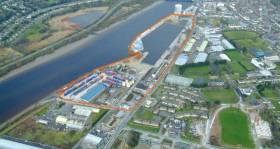Displaying items by tag: Limerick Docklands
Limerick €100m Docklands Plan Could Create 1,000 Jobs
#ShannonEstuary - Plans to transform 75 acres of Limerick docklands estate writes The Irish Times, into an economic hub will create more than 1,000 jobs and involve a minimum of €100 million of development, organisers have said.
The Shannon Foynes Port Company (SFPC) published on Friday its Limerick Docklands Framework Strategy (click Video) designed to transform the area just off Limerick city centre.
The assets earmarked for development include disused buildings and greenfield land banks that are surplus to the operational needs of the thriving Ted Russell Docks.
“The docks have been and will remain the core SFPC commercial activity at the Limerick docklands estate, which extends 2.15km along the river Shannon waterfront,” said the company.
“However, the strategy is the first time that non-core assets will be explored for their commercial potential in a programme that will attract significant inward investment and potentially in excess of 1,000 jobs.”
The company said the programme could involve a minimum of €100 million of development, potentially delivering 75,000sq m of new and existing buildings at the Ted Russell Docks, Corcanree Business Park and other sites off the Dock Road.
The company has already had discussions with a number of potential partners on individual projects within the wider scheme with a view to enabling works to begin on initial projects next year.
For more on the major redevelopment click here.






























































